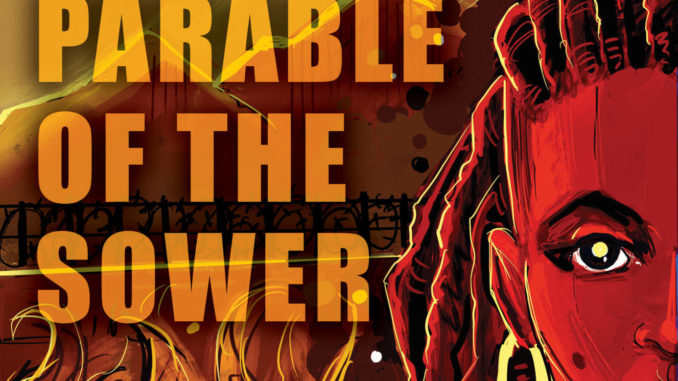
The first thing you notice about the graphic novel adaptation of Octavia E. Butler’s ‘Parable of the Sower’ by John Jennings and Damian Duffy is the cover. A young black woman looks clearly out as if she can see right through you. Directly behind and close to her is a smoldering flame, amidst a hill-like community in the distance. That young woman with determination in her eye is Lauren Olamina. She’s daring you to put your story alongside hers. You can try, just hold the book cover next to your face, there you will see a complete picture. A joining of stories, of ancestral ties, a connection is at play before you read a word. Once opened hold on. There’s going to be a demand on the reader to rethink every decision ever made about your relationship with humanity.
Lauren comes from a religious family and in 2024 she with other peers are about to be baptized. The bike ride from their gated community to the church shows California as a dystopia where every bad thing you could think of happening to a person has come true for entire neighborhoods. There are naked women with vapid eyes, decapitated bodies, people with sores, wanderers. For the average person they may be able to shake these scenes off as their normal, but for Lauren and her hyper-empathy it’s a literal minefield. Not only does she feel the pain of others it can sometimes manifest on her body. This is a vulnerability that she must hide. Another running theme in ‘Sower’ is Lauren’s need to forge a new belief system, one that makes sense to her in the reality she’s living in. Throughout the graphic novel Jennings and Duffy visually bring Butler’s prose into your consciousness. Perhaps more so than in their previous collaboration ‘Kindred’ since this book takes place closer to the times we’re living in rather than antebellum Maryland and 1976 California. Between the environment, political climate and social actions of the 2000’s ‘Sower’ can be perceived as a horror story come to life. That bike ride taken in the beginning of the graphic novel is closer to what too many people see every day.
Lauren’s religion Earthseed can be seen as the answer to the sower parable in the ‘Bible’ where Jesus gives a way to spread his gospel. He talks of the four ways in which seeds are planted. From rocks to bad soil, seeds would not be able to take root and grow. Lauren after seeing her community devasted and violently loses her family seeks out that fourth way where seeds are planted on good soil and given time to be nourished and develop. Visually ‘Parable of the Sower’ takes you on a four part journey with Lauren where you also become hyper-empathetic. There’s a sense that you meet up with people and places where her Earthseed can grow until Lauren eventually meets up with people who willing to join her. Everything you see you can’t help but feel and experience. The longform comic book will change you, may even traumatize you. Read it anyway. You must, if for no other reason than to understand where you can fit in the world.

Leave a Reply